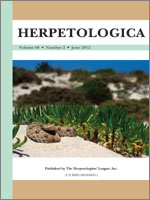Postrelease movements can determine the success of wildlife translocations. We monitored movements of 36 captive-reared Ozark Hellbenders (Cryptobranchus alleganiensis bishopi) released to augment wild populations at two sites on the North Fork of the White River (Missouri, USA). We used radiotelemetry to collect 3610 Hellbender locations from May 2008 to August 2009. We quantified movements at multiple spatio-temporal scales and made comparisons between two seasons of monitoring (1 = release–December 2008; 2 = January 2009–August 2009). At the finest (daily) scale, most Hellbenders (90%–94% per season) were highly sedentary (≥50% of observations indicated no movement). Typical distances between daily locations when Hellbenders moved were <5 m in Season 1 (median = 3.08 m, n = 331; range = 0.19–903.00) and <2 m in Season 2 (median = 1.80 m; n = 161; range = 0.21–34.00). During the study Hellbenders rarely (35 of 492 movements) travelled >20 m between daily locations, and virtually all (34 of 35) such movements occurred in Season 1. At a broader scale, home ranges of Hellbenders varied widely in Season 1 (range = 0.66–986.92 m2, n = 26), but in Season 2 averaged only 31.33 m2 (± 11.81 SE, n = 8) and 11.08 m2 (± 3.25 SE, n = 7) at respective sites. Among Hellbenders monitored long enough to exhibit settlement (estimation of a home range) 69% (18 of 26) dispersed ≤50 m from the point of release. We only noted mortality associated with dispersals >50 m at one site, when it coincided with abandonment of core habitat that was one-third as large as at the other site. At the broadest scale, 68% and 86% of Hellbenders settled in core habitat of respective release sites, and most had settled within 21 d postrelease (range = 0–49 d). Collectively, Hellbender movements indicated a short period of exploration followed by more permanent settlement and high site fidelity typical of wild conspecifics. Captive-reared juvenile Hellbenders may be well suited for translocation; however, the quality of habitat at fine scale (10–30 m2) and the extent of suitable habitat within release sites are important considerations.
How to translate text using browser tools
1 June 2012
Postrelease Movements of Captive-Reared Ozark Hellbenders (Cryptobranchus alleganiensis bishopi)
Catherine M. Bodinof,
Jeffrey T. Briggler,
Randall E. Junge,
Jeff Beringer,
Mark D. Wanner,
Chawna D. Schuette,
Jeff Ettling,
Robert A. Gitzen,
Joshua J. Millspaugh
ACCESS THE FULL ARTICLE

Herpetologica
Vol. 68 • No. 2
June 2012
Vol. 68 • No. 2
June 2012
amphibian
captive-reared
Cryptobranchus alleganiensis
hellbender
home range
movement
Release site fidelity




